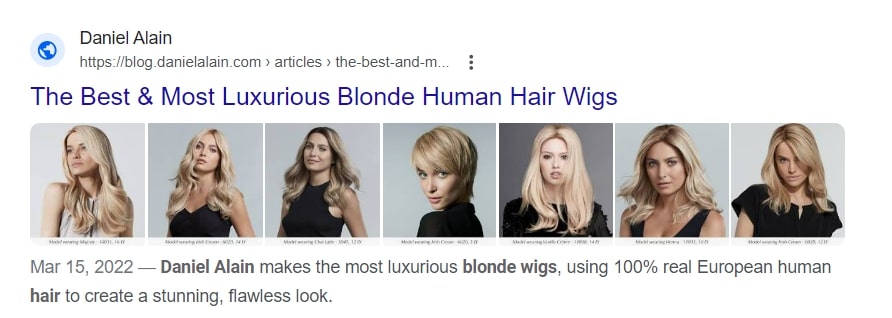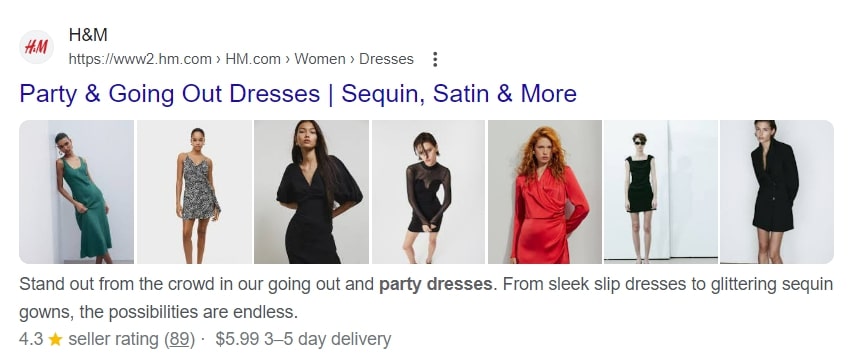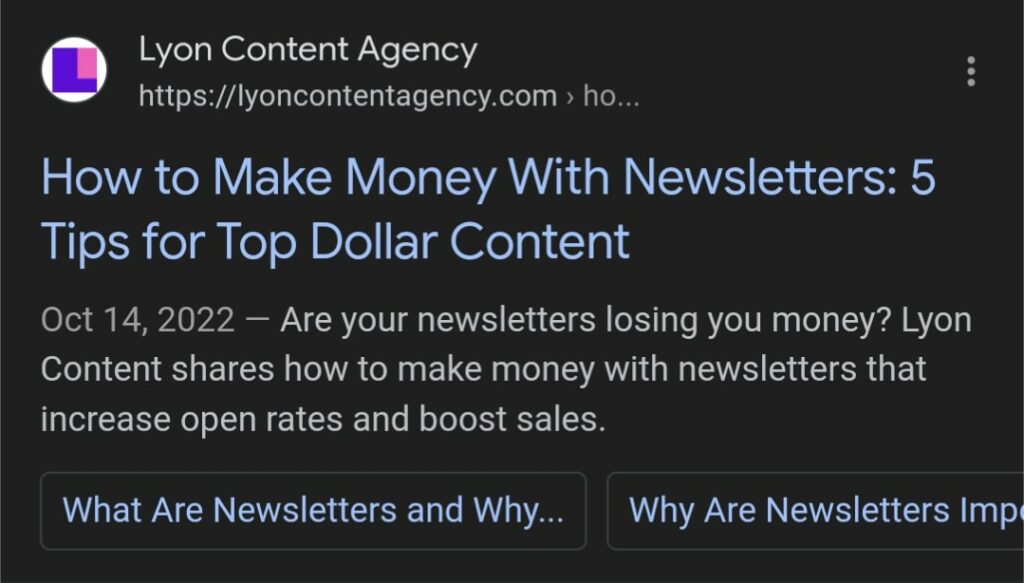What you’ll learn
Every marketer craves conversions, but you can’t get those until you get clicks, a.k.a. people visiting your website. The more clicks you get from your ads, the higher your clickthrough rate (CTR), and eventually? The higher your conversion rate.
But only if your content delivers, from your images and written copy all the way to your meta titles.
We chatted with Kim Fischer, Lyon Content’s SEO guru, about how to improve meta titles with target keywords, audience research, and more expert tips, so keep reading as we share all the details.

What is a meta title?
A meta title is the blue title text within a website result on the search engine results page (SERP). It’s also the title text for pay-per-click ad copy on the SERP.
Here’s an example from our luxury alternative hair client, Daniel Alain:

The meta title is the title text in blue (not to be confused with the meta description tag, which comes after the meta title and in the example above, after the display images).
Title tags are HTML elements you create in your website’s code. Here’s what it looks like on the backend:
<head><title>Your Title</title></head>
Of course, you might use a content management system (CMS) that requires no code, like WordPress or Squarespace, in which case you just plug in this info from your editing dashboard where you create new content.
The best meta titles succeed in a difficult feat: describing an entire page of content within just a few words.
How to write a good meta title
Why is it that writer’s block strikes hardest when you have fewer words to come up with? Every element of your ads campaign might already be finalized, but the title just won’t come out.

We feel you. Don’t worry; you’re not alone. We’re going to roll up our sleeves with you and get those meta titles on paper.
Start with audience research for title tags
Most of the content we write for our clients starts with a deep understanding of their audience. And title tags are no different:
“The searcher’s intent is going to be vital for writing the meta title,” says Kim. “The user wants to know if their questions will be answered by clicking it.”
That remains true for every target audience.
Whether it’s a 20-something college student looking for a new party dress…

Or a middle-aged mom looking for anti-aging skincare…

Bottom line? Your meta title should convince your audience that your products are the solution to their problem.
Psssst. Need help defining your intended audience? We’ve got a guide on that, too.
Follow best practices
You have a million different ways to bake a cake, even if that cake only has a few ingredients. Meta titles only have a few words, but a few techniques can be the difference between a click and a dreaded scroll (swerve).
Here are Kim’s savvy SEO secrets for crafting captivating meta titles:
- Reflect your content: Are you writing a how-to guide, contact page, or industry review? Whatever your content is, reflect it in your title tag.
- Stand out from competitors: Include a primary keyword, but ensure your title tag uses different emotional appeal and structure from your competitors. For example, if your lip balm competitor’s article title is “Best Lip Balms for Dry Lips 2024,” jazz your title up with something like “5 Lip Balms to Soothe Chapped Lips this Winter”
- Stick to 6-10 words, tops: The fewer the better, as long as they capture your audience’s attention.
Speaking of length…
How long should a meta title be?
Meta titles don’t have a specified length guideline on any of Google’s resources. But Moz points out that the search result will generally display between 50 to 60 characters. Any longer than that, and an ellipses (…) will replace your title.
When you write meta descriptions, on the other hand, you have more wiggle room. These are more detailed descriptions of your content, with a limit of up to 160 characters.
You’ve got the basics down, but how can you optimize meta titles for higher CTR?

How to increase CTRs with meta tags
We know it’s hard to think of other metrics when you’re occupied with conversion rate and revenue. But CTR is just as important. It speaks to your brand awareness, and it’s also a necessary precursor to the conversions you desire!
Here are some tips to improve your CTR with meta tags.
Target the right keywords
What if you could sneak in 2-3 keywords within the meta title character limit? Sure, you might capture more than one audience search query. But be careful not to prioritize Google’s algorithms over your audience by going overboard with keywords.
Even Google recommends you avoid keyword stuffing. Kim says the primary keyword is more than enough:
“The primary keyword should definitely be included, but mostly for context to the reader,” explains Kim. “Meta tags are not a huge ranking factor, but more of a user experience (UX) factor for readers.”
A good rule of thumb is to align your title with your content above all else. With that in mind, clicks will follow:
“When meta titles are custom written for the content, rather than letting Google pull whatever it thinks is relevant, those have higher CTRs,” says Kim.
Keep it simple and skimmable
It’s a title, after all. You have an entire web page to dive deeper into your brand offerings and expertise.
If you get too wordy in your meta title, your audience won’t read it. Not because they don’t want to — Google will literally cut it off, forcing your audience to flock to a competitor.
So keep it short, sweet, and skimmable.
Include a call to action for service and sales pages
A call to action (CTA) is a piece of text, usually a short sentence, that invites your audience to take action by clicking onto something, like a newsletter sign-up, another blog post, a contact form, and so on.
We use CTAs to wrap up many different types of content, including email newsletters, social media posts, and blog articles (there is one waiting for you at the bottom of this page 😉).
But do they belong in your meta title? Kim says the industry is torn:
“This is controversial,” says Kim. “Some studies have shown a positive impact for CTAs in titles, and others have not.”
For example, Semrush found a negative effect on clickthrough rate (decreased by 14.9%) in their A/B test of meta titles with CTAs.
But Kim sees a case for them depending on the purpose of the page.
Any page (like a service page) that’s geared toward bottom-funnel audiences (those closer to making a purchase decision) will feel more sales-centric. These might benefit better from a title CTA than a blog post. Here’s a great example for our client HawkSEM’s SEO service page title tag:

If you choose to include a CTA in your meta title, keep it simple.
PartnerStack, a partnership marketing platform for B2B brands, experienced a 111% conversion rate increase after changing their landing page CTA from Book a Demo to Get Started. From that, we gather that less is more, and that’ll be even more true within the character confines of a meta title.
But if we’re talking about an informative blog post that appeals to top-funnel audiences (awareness stage)? You can craft a slamming meta title that captures your page’s content without a CTA, like we did for our email newsletter blog:

What is a good clickthrough rate?
CTR depends on your ranking position on the search results. For example, Semrush points out that the first organic result has an average clickthrough rate of 27.6%. That decreases as you go down the SERP, to 6.3% at position 5, 3.3% at position 8, and 2.4% at position 10.
So, what’s a good CTR to aim for? We’d say anything over 2% is decent, but you can bring that up with higher SERP rankings, images, and, of course, optimized title tags.

Boost CTR with Lyon Content!
Meta titles have a lot in common with that first Bumble message — they need to capture attention without coming off as desperate.
The best way to do that? Focus on one primary keyword, align each word to your content subject matter, and inform that content with audience research. You can even spice up sales pages with CTAs in your title tags for added oomph.
But if you find yourself fruitlessly brainstorming and wasting entire afternoons thinking of good meta titles? Call for reinforcements, and we’ll come with our digital pen at the ready. Lyon Content has a team of creative content writers who think of meta titles on the fly, daily.
Your clicks are calling — let’s answer them with killer content.

02/20/2024
Chrissy is a contributing writer at Lyon Content based in Toronto. She loves writing and editing tech, marketing, and lifestyle content. But her favorite part of writing is helping businesses express themselves. When she isn't writing, she's traveling as much as possible and eating a lot of cheese.





